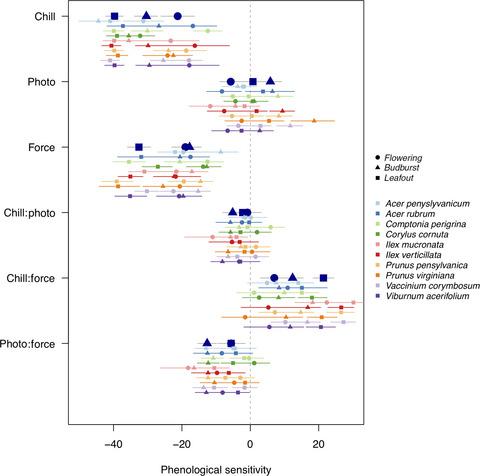Our official English website, www.x-mol.net, welcomes your
feedback! (Note: you will need to create a separate account there.)
Differences between flower and leaf phenological responses to environmental variation drive shifts in spring phenological sequences of temperate woody plants
Journal of Ecology ( IF 5.3 ) Pub Date : 2021-05-22 , DOI: 10.1111/1365-2745.13708 D.M. Buonaiuto 1, 2 , E.M. Wolkovich 3
中文翻译:

花叶物候响应对环境变化的差异驱动温带木本植物春季物候序列的变化
更新日期:2021-05-22
Journal of Ecology ( IF 5.3 ) Pub Date : 2021-05-22 , DOI: 10.1111/1365-2745.13708 D.M. Buonaiuto 1, 2 , E.M. Wolkovich 3
Affiliation

|
- The relative timing of growth and reproduction is an important driver of plant fitness. For deciduous woody species in temperate regions, leaves and flowers both appear in the early spring, but the order and duration of these phenological events vary among species, populations and individuals. Researchers have long hypothesized that this variation in flower–leaf sequences (FLSs) may be important—affecting the reproduction, recruitment and survival of individuals. Furthermore, FLSs appear to be shifting with climate change; thus, anticipating the extent of these shifts may influence projections of how climate change impacts species' performance and reshapes forest communities.
- Predicting FLS shifts requires an improved understanding of how environmental variation dictates FLS patterns. To address this, we compared the phenological responses of flowers and developing leaves for 10 temperate woody species to varying levels of temperature and photoperiod in a lab experiment. Our experimental design allowed us to test competing hypotheses for how environmental cues determine FLS variation—specifically whether forcing (warm temperatures) alone drives variation or differential sensitivity to chilling (cool temperatures generally in the fall/winter) and/or photoperiod matter.
- Within species, we found that flower and leaf phenology responded with differential sensitivity to environmental cues, with differences in their response to chilling being the dominant driver of FLS variation. These differences between flowering and leaf responses were consistent across species, but because species differ in the order of phenological events in their FLSs (flowering-first versus leafing-first), differences between flower and leaf phenology will have contrasting impacts on FLS variation across species. Simple projections of FLS shifts with climate change showed large shifts in species that flower before leafing, with flower–leaf interphases substantially shortened. For wind-pollinated species, this shorter interphase would reduce the time period for efficient pollen transfer, and thus raises the possibility that wind-pollinated taxa may experience reproductive declines due to FLS shifts.
- Synthesis. Our study provides strong evidence that flower and leaf phenology responds with differential sensitivity to environmental variation. Because climate change will amplify variability in temperature across time and space, our findings suggest that FLS shifts may be large, but are likely to vary substantially among populations and species. Our analyses indicate that climate change will likely decrease flower–leaf interphases, especially in flowering-first species. FLS shifts are likely to affect fitness for some species more strongly than others, thereby impacting community structure and function as climate continues to change.
中文翻译:

花叶物候响应对环境变化的差异驱动温带木本植物春季物候序列的变化
- 生长和繁殖的相对时间是植物健康的重要驱动因素。对于温带地区的落叶木本植物来说,叶和花都出现在早春,但这些物候事件的顺序和持续时间因物种、种群和个体而异。长期以来,研究人员一直假设这种花叶序列 (FLS) 的变异可能很重要——影响个体的繁殖、招募和生存。此外,FLS 似乎随着气候变化而变化;因此,预测这些变化的程度可能会影响对气候变化如何影响物种表现和重塑森林群落的预测。
- 预测 FLS 变化需要更好地了解环境变化如何决定 FLS 模式。为了解决这个问题,我们在实验室实验中比较了 10 种温带木本植物的花朵和发育叶片对不同温度和光周期水平的物候响应。我们的实验设计使我们能够测试环境线索如何决定 FLS 变化的竞争假设——特别是强迫(温暖的温度)是否单独驱动变化或对寒冷(通常在秋季/冬季的凉爽温度)和/或光周期物质的差异敏感性。
- 在物种内,我们发现花和叶物候对环境线索的敏感性不同,它们对寒冷的反应差异是 FLS 变异的主要驱动因素。开花和叶响应之间的这些差异在物种之间是一致的,但是因为物种在其 FLS 中物候事件的顺序不同(开花先与生叶先),花和叶物候之间的差异将对跨物种的 FLS 变异产生对比影响. FLS 随气候变化而变化的简单预测表明,开花前开花的物种发生了巨大变化,花叶间期显着缩短。对于风媒物种,这种较短的相间期将减少有效花粉转移的时间,
- 合成。我们的研究提供了强有力的证据,表明花和叶物候对环境变化的敏感性不同。由于气候变化会放大温度随时间和空间的变化,我们的研究结果表明 FLS 变化可能很大,但可能在种群和物种之间存在很大差异。我们的分析表明,气候变化可能会减少花叶间期,特别是在先开花的物种中。FLS 变化可能比其他物种更强烈地影响某些物种的适应性,从而随着气候的持续变化影响群落结构和功能。










































 京公网安备 11010802027423号
京公网安备 11010802027423号